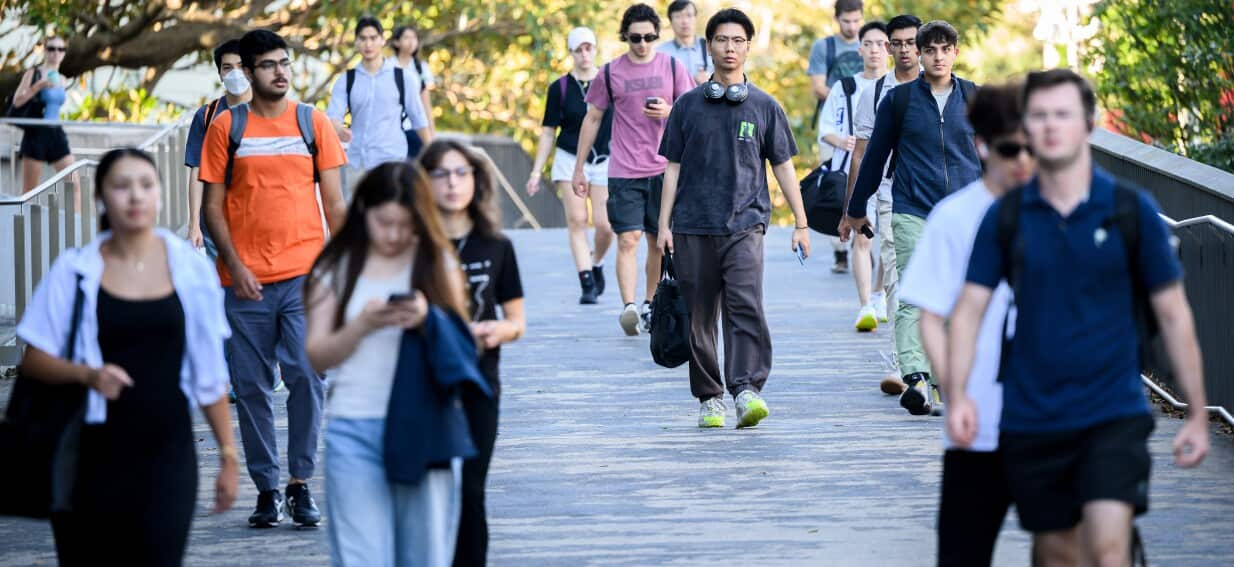Worldwide college students have confronted blame from either side of politics for ostensibly contributing to rising housing prices.
For instance, Treasurer Jim Chalmers that elevated numbers of overseas college students “places stress on costs and rents”.
That very same month, Victorian Liberal Senator Jane Hume advised Sky Information that they put “distinctive stress” on housing markets.
Nonetheless, they’re “not the culprits of the rental disaster in Australia” and its authors “reject the belief that the expansion of worldwide college students ‘precipitated’ or exacerbated the housing disaster in Australia”.
“Worldwide college students solely constituted a small a part of the puzzle of the rental disaster in Australian capital cities,” the College of South Australia analysis paper learn.
‘There’s actually no sample’
Lead researcher Michael Mu advised SBS Information his crew checked out a number of completely different variables, together with worldwide scholar numbers, rental emptiness charges, inflation charges, and rental prices.
“The primary message right here is, as a result of the correlations between the worldwide [students] numbers and the rental prices are random, there’s actually no sample,” he mentioned.
“We do not have proof that worldwide college students make discovering housing more durable for everybody.”
The analysis additionally confirmed that, after COVID-19 mitigation measures have been lifted, a rise of 10,000 worldwide college students led to corresponding lower of $1 in weekly rents when “rental inflation was managed and rental emptiness price was thought-about”.
Hu mentioned “very sophisticated macro-level socio-economic causes” have been what was really behind the housing disaster.
“[International students] usually are not the principle rivals available in the market, and truly, when a few of them do select to go to the personal rental market, they’re very weak,” he defined.
“That maybe helps to elucidate why we discovered actually no statistical relationship between worldwide members and the housing disaster.”
The researchers examined knowledge from authorities departments and the Australian Bureau of Statistics (ABS) over 70 time factors between 2017 and 2024.
Worldwide college students are at an obstacle in renting
The latest findings align with 2024 analysis from the Pupil Lodging Council that additionally discovered worldwide college students weren’t accountable for rising costs.
Worldwide college students make up simply six per cent of renters nationally, have been concentrated in capital cities, and virtually 40 per cent of them dwell in scholar housing, the council’s analysis discovered.
“We do have a rental disaster in Australia, and it is a lengthy and systemic downside made up of numerous various factors, however to unfairly place the blame solely on the ft of worldwide college students is improper,” Tori Brown, the manager director of the Pupil Lodging Council, advised SBS Information.
Brown additionally mentioned that the organisation’s analysis confirmed that worldwide college students have been deprived when competing within the personal rental market.
“Worldwide college students don’t have any earlier rental historical past residing in Australia, and so they often do not have jobs or earnings statements once they’re placing in for leases.”
A ‘tariff’ on worldwide college students?
In the meantime, authorities efforts to scale back the variety of worldwide college students learning in Australia seem to have had some impact.
In line with the ABS, there have been practically 81,000 worldwide scholar arrivals in January — 2.5 per cent lower than the identical time final 12 months and 10 per cent lower than pre-COVID-19 numbers.
Final 12 months, the federal government tried to cap worldwide scholar numbers and instructed limiting worldwide scholar enrolments to 270,000 by 2025.
The plan was scrapped after failing to win .
In response, the federal government launched a
It was enforced by a ministerial course reasonably than a invoice.
The Opposition is planning to unveil its personal coverage to restrict the variety of worldwide college students, with its training spokesperson Sarah Henderson saying it might include “harder, more practical caps on worldwide college students”.
“Our method will guarantee you’ve got long run certainty, underpinned with correct session, with particular consideration for the areas the place overseas college students are integral to native economies,” Henderson mentioned on the Universities Australia Options Summit in mid-March.
Specialists like UNSW economics professor Richard Holden warn that capping worldwide college students will “undoubtedly scale back GDP”.
“It is vital to keep in mind that every worldwide scholar that involves Australia not solely brings within the tuition charges that they pay to the college, however they, they spend cash in the remainder of the economic system,” he mentioned.
“That is why they’re in a extremely vital a part of our financial success story and our export success story.”
In line with the ABS, worldwide training was Australia’s fourth largest export — valued at $48 billion — in 2023. They paid $17 billion in course charges and spent $31 billion inside the broader economic system.
The Pupil Lodging Council additionally opposes the cap.
Brown mentioned that, as Australia’s largest service export, worldwide college students “cannot have a tariff positioned on them”.
“They’re essential to our economic system and to Australia’s future.
“What we assist is ensuring that there is acceptable housing alternative for college kids in and round the place they wish to dwell, and meaning methods to construct extra scholar lodging.”










